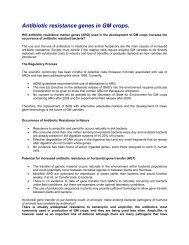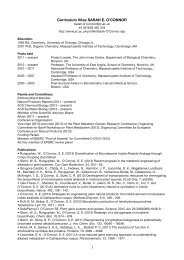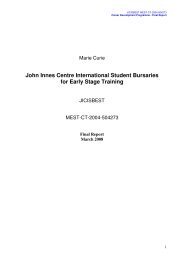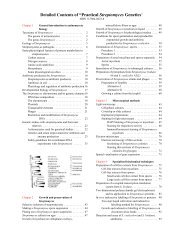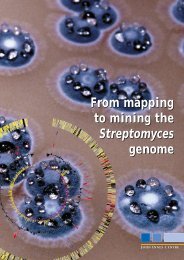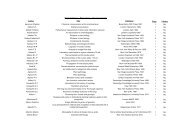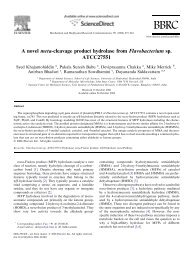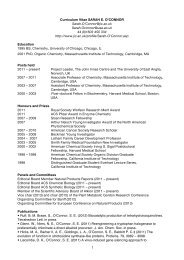1910s Timeline - John Innes Centre
1910s Timeline - John Innes Centre
1910s Timeline - John Innes Centre
You also want an ePaper? Increase the reach of your titles
YUMPU automatically turns print PDFs into web optimized ePapers that Google loves.
1944 Flying bomb offensive<br />
hits JIHI<br />
Until 1944 damage to the<br />
Institution from enemy attacks<br />
has been slight. Only one bomb,<br />
which fell in the Old Garden in<br />
May 1941, directly damaged the<br />
premises. A serious attack in the<br />
neighbourhood in February<br />
1944 also leaves the Institution<br />
unscathed. The flying bomb<br />
offensive launched in June 1944<br />
is more prolonged, and in the<br />
Merton locality, more<br />
dangerous than previous<br />
attacks. One of the first flying<br />
bombs kills the Assistant<br />
Secretary to the Council of JIHI.<br />
Between June and August 1944<br />
eight flying bombs damage the<br />
buildings and private houses of<br />
the Institution but there are no<br />
further casualties. The last of<br />
these bombs, falling on the<br />
Sunday afternoon of August<br />
20 th , causes extensive blast<br />
damage to glasshouses, and the<br />
windows, roofs and ceilings of<br />
JIHI’s main buildings; the main<br />
water pipes are also fractured.<br />
Despite a general scene of<br />
‘appalling desolation’ no books<br />
are destroyed and very little<br />
apparatus lost. Nor is there any<br />
structural damage to the<br />
buildings. Most of the<br />
immediate problems with the<br />
buildings are quickly rectified<br />
and within a fortnight work is<br />
again possible. The glasshouses<br />
take longer to replace- it is not<br />
until November that glass<br />
(cloudy glass) becomes<br />
available. Many of the trees,<br />
crops and experimental plants<br />
are ruined and some (for<br />
example, the entire Antirrhinum<br />
crop) are totally obliterated. As<br />
a result of the damage the<br />
greater part of the breeding<br />
work of the year is spoiled,<br />
jeopardized or delayed.<br />
1944 Colour photography is<br />
introduced to JIHI<br />
Since H. C. Osterstock’s death in<br />
1942 the Institution has felt the<br />
need of a means of representing<br />
fruits, flowers and microscopic<br />
objects in colour. They could not<br />
expect to replace Ostertock in<br />
skill of painting but in 1944<br />
obtain the advice of an expert<br />
colour photographer, G. D. H.<br />
Waddington. The Institution<br />
purchases new photographic<br />
equipment and Waddington<br />
agrees to make a series of<br />
colour photographs of<br />
important fruits, flowers and<br />
vegetables, and especially new<br />
varieties raised by the<br />
Institution. Waddington also<br />
trains Len La Cour and Gavin<br />
Brown in the ordinary<br />
techniques of colour<br />
photography. A new senior<br />
photographer, L. S. Clarke, is<br />
appointed in July 1948 to fill<br />
Osterstock’s long-vacant<br />
position.<br />
1944 DNA is ‘transforming<br />
principle’<br />
Physician and medical<br />
researcher Oswald Avery at<br />
Rockefeller University Hospital<br />
in New York City, with coworkers<br />
Colin MacLeod and<br />
Maclyn McCarty, shows that<br />
DNA can transform the<br />
properties of cells. Avery and his<br />
team’s experiments on<br />
Streptococcus pneumoniae<br />
followed up the work of<br />
Frederick Griffith who in 1928<br />
showed that some component<br />
of heat-killed virulent bacteria<br />
can ‘transform’ a non-virulent<br />
strain to become virulent. Avery<br />
and his colleagues working in<br />
the early 1940s demonstrated<br />
that the ‘transforming principle’<br />
identified by Griffith was not<br />
some kind of protein as had<br />
been supposed but was a<br />
substance rich in nucleic acids.<br />
This agent (DNA) was able to<br />
produce heritable change in<br />
organisms. Avery’s work helped<br />
Page 40 of 91



